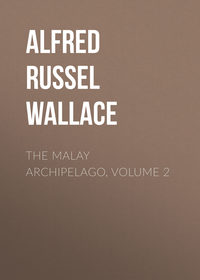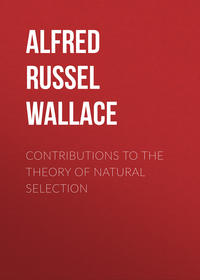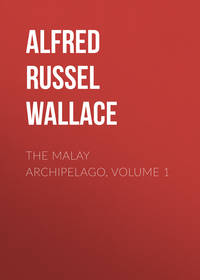 полная версия
полная версияTravels on the Amazon
The complete history of these changes,—the periods of elevation and of repose, the time when the dividing ridges first rose above the waters, and the comparative antiquity of the tributary streams,—cannot be ascertained till the country has been more thoroughly explored, and the organic remains, which must doubtless exist, be brought forward, to give us more accurate information respecting the birth and growth of the Amazon.
PLATE IV.
Comparative Climates of Pará and London.
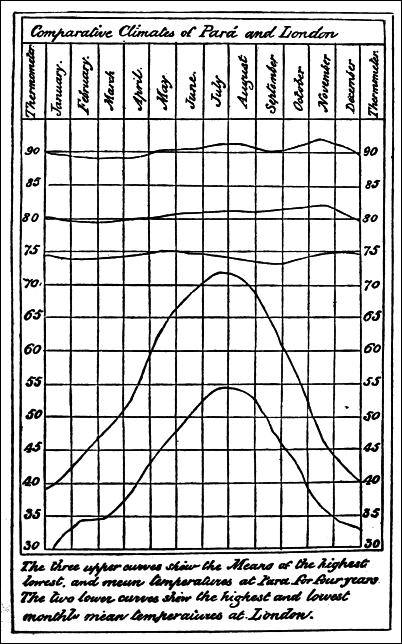
The three upper curves show the Means of the highest lowest and mean temperatures at Para for four years. The two lower curves show the highest and lowest monthlhy mean temperatures at London.
PLATE V.
Mean Atmospheric Pressure at Para for 3 years.
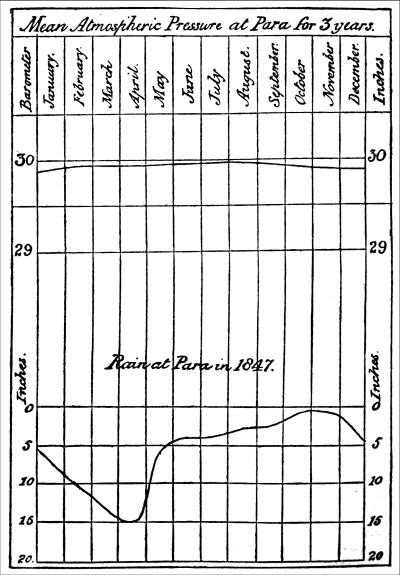
CLIMATE
The climate of the Amazon valley seems remarkable for uniformity of temperature, and for a regular supply of moisture. There are, in most parts of it, six months' wet, and six months' dry season, neither of which are so severe as in some other tropical countries. From June to December is the dry, and from January to May the wet season. In the dry season there are a few occasional rains, especially about All Saints' day, in November; and during the wet season there are intervals of fine weather, and often bright mornings, and many days of gentle misty rain.
This is the general character of the climate over the whole of the main stream of the Amazon and its immediate neighbourhood. There are, however, remarkable deviations from this general routine, in particular localities. Pará itself is one of these exceptional places. Here the seasons are so modified, as to render the climate one of the most agreeable in the world. During the whole of the dry season, scarcely ever more than three days or a week passes without a slight thunderstorm and heavy shower, which comes on about four in the afternoon and by six has cleared off again, leaving the atmosphere delightfully pure and cool and all vegetable and animal life refreshed and invigorated. Had I only judged of the climate of Pará from my first residence of a year, I might be thought to have been impressed by the novelty of the tropical climate; but on my return from a three years' sojourn on the Upper Amazon and Rio Negro, I was equally struck with the wonderful freshness and brilliancy of the atmosphere, and the balmy mildness of the evenings, which are certainly not equalled in any other part I have visited.
The wet season has not so many stormy and cloudy days as in other parts. Sunshine and rain alternate, and the days are comparatively bright and cheerful, even when rainy. Generally, the variation of the thermometer in any one day does not exceed 15°; 75° being the lowest, and 90° the highest. The greatest variation in one day is not, I think, ever more than 20°; and in four years, the lowest and highest temperatures were 70° and 95°, giving only an extreme variation of 25°. A more equable climate probably does not exist on the earth. (See Diagram, Plate IV.)
On the Guiana side of the Amazon, in the islands of Mexiana and Marajo, the seasons are more strongly marked than even higher up the river. In the dry season, for about three months, no rain ever falls; and in the wet it is almost continual.
But it is in the country about the falls of the Rio Negro that the most curious modification of the seasons occur. Here the regular tropical dry season has almost disappeared, and a constant alternation of showers and sunshine occurs, almost all the year round. In the months of June, July, August, and September, when the Amazonian summer is in all its glory, we have here only a little finer weather about June, and then rain again as much as ever; till, in January or February, when the wet season in the Amazon commences, there is generally here a month or two of fine warm weather. It is then that the river, which has been very slowly falling since July, empties rapidly, and in March is generally at its lowest ebb. In the beginning of April it suddenly begins to rise, and by the end of May has risen twenty feet, and then continues slowly rising till July, when it reaches its highest point, and begins to fall with the Amazon. The district of the greatest quantity of rain, or rather of the greatest number of rainy days, seems to be very limited, extending only from a little below the falls of São Gabriel to Marabitanas at the confines of Brazil, where the Pirapocó and Cocoí mountains, and the Serra of Tunuhy, seem to form a separation from the Venezuela district, where there is a more regular summer in the months of December, January, and February.
The water of the Rio Negro in the month of September did not vary in temperature more than two degrees. I unfortunately lost my thermometers, or had intended making a regular series of observations on the waters of the higher parts of the rivers I ascended.
The extreme variation of the barometer at Pará for three years was only three-tenths of an inch (see diagram, Plate V.). The mean height, with all the necessary corrections, would seem to be almost exactly thirty inches; I have, however, already given my reasons for believing that there is a considerable difference in the pressure of the atmosphere in the interior of the country. In the month of May some very cold days are said to occur annually on the Upper Amazon and Rio Negro; but I never myself experienced anything of the kind worthy of notice. Many intelligent persons have assured me that the cold is sometimes so severe that the inhabitants suffer much, and, what is much more extraordinary, the fishes in the rivers die of it. Allowing this to be the fact, I am quite unable to account for it, as it is difficult to conceive that a diminution of temperature of five or ten degrees, which is as much as ever takes place, can produce any effect upon them.
I have an authentic account of hail having once fallen on the Upper Amazon, a remarkable occurrence at a place only three degrees south of the equator, and about two hundred feet above the level of the sea. The children were out at play, and brought it to their parents, astonished at a substance falling from the clouds quite new to them, and which was so remarkably cold. The person who told me was a Portuguese, and his information can be perfectly relied on.
CHAPTER XV
VEGETATION OF THE AMAZON VALLEYPerhaps no country in the world contains such an amount of vegetable matter on its surface as the valley of the Amazon. Its entire extent, with the exception of some very small portions, is covered with one dense and lofty primeval forest, the most extensive and unbroken which exists upon the earth. It is the great feature of the country,—that which at once stamps it as a unique and peculiar region. It is not here as on the coasts of southern Brazil, or on the shores of the Pacific, where a few days' journey suffices to carry us beyond the forest district, and into the parched plains and rocky serras of the interior. Here we may travel for weeks and months inland, in any direction, and find scarcely an acre of ground unoccupied by trees. It is far up in the interior, where the great mass of this mighty forest is found; not on the lower part of the river, near the coast, as is generally supposed.
A line from the mouth of the river Parnaiba, in long. 41° 30´ W., drawn due west towards Guayaquil, will cut the boundary of the great forest in long. 78° 30´, and, for the whole distance of about 2,600 miles, will have passed through the centre of it, dividing it into two nearly equal portions.
For the first thousand miles, or as far as long. 56° W., the width of the forest from north to south is about four hundred miles; it then stretches out both to the north and south, so that in long. 67° W. it extends from 7° N., on the banks of the Orinoko, to 18° S., on the northern slope of the Andes of Bolivia, a distance of more than seventeen hundred miles. From a point about sixty miles south-east of Tabatinga, a circle may be drawn of 1,100 miles in diameter, the whole area of which will be virgin forest.
Along the Andes of Quito, from Pasto to Guancabamba, it reaches close up to the eastern base of the mountains, and even ascends their lower slopes. In the moderately elevated country between the river Huallaga and Marañon, the forest extends only over the eastern portion, commencing in the neighbourhood of Moyobamba. Further on, to the east of Cuzco and La Paz, it spreads high up on the slopes of the Bolivian Andes, and passing a little to the west of Santa Cruz de la Sierra, turns off to the north-east, crossing the Tapajóz and Xingú rivers somewhere about the middle of their course, and the Tocantins not far above its junction with the Araguàya, and then passes over to the river Parnaíba, which it follows to its mouth.
The Island of Marajó, at the mouth of the Amazon, has its eastern half open plains, while in the western the forest commences. On the north of the Amazon, from its mouth to beyond Montealegre, are open plains; but opposite the mouth of the Tapajóz at Santarem, the forest begins, and appears to extend up to the Serras of Carumaní, on the Rio Branco, and thence stretches west, to join the wooded country on the eastern side of the Orinoko. West of that river, it commences south of the Vicháda, and, crossing over the upper waters of the Guaviáre and Uaupés, reach the Andes east of Pasto, where we commenced our survey.
The forests of no other part of the world are so extensive and unbroken as this. Those of Central Europe are trifling in comparison; nor in India are they very continuous or extensive; while the rest of Asia seems to be a country of thinly wooded plains, and steppes, and deserts. Africa contains some large forests, situated on the east and west coasts, and in the interior south of the equator; but the whole of them would bear but a small proportion to that of the Amazon. In North America alone is there anything approaching to it, where the whole country east of the Mississippi and about the great lakes, is, or has been, an almost uninterrupted extent of woodland.
In a general survey of the earth, we may therefore look upon the New World as pre-eminently the land of forests, contrasting strongly with the Old, where steppes and deserts are the most characteristic features.
The boundaries of the Amazonian forest have not hitherto been ascertained with much accuracy. The open plains of Caguan have been supposed much more extensive than they really are; but I have very nearly determined their limits to the south and east, by the observations I made, and the information I obtained in my voyage up the Uaupés. Again, on the Uaycáli there is a district marked on the maps as the "Pampas del Sacramento," which has been supposed to be an open plain; but the banks of the Amazon up to the mouth of the Uaycáli are clothed with thick forest, and Messrs. Smyth and Lowe, who crossed the Pampa in two places, found no open plains; and from their observations and those of Lieut. Mawe we must extend the forest district up to near Moyabamba, west of the Huallaga, and to the foot of the mountains east of Pasco and Tarma. I was informed by a native of Ecuador, well acquainted with the country, that the Napo, Tigre, Pastaza, and the adjacent rivers all flow through dense forest, which extends up even to Baéza and Canélos and over all the lower slopes of the Andes. Tschudi informs us that the forest districts commence on all the north and east slopes of the Andes of Peru, near Huánta, and at Urubámba north of Cúzco. I have learnt from a gentleman, a native of La Paz, that immediately on crossing the Bolivian Andes from that city and from Oropéssa and Santa Cruz, you enter the great forests, which extend over all the tributaries of the Madeira. Traders up the Purús and all the southern branches of the Upper Amazon, neither meet with, nor hear accounts of, any open land, so that there is little doubt but that the extent here pointed out is one vast, ever-verdant, unbroken forest.
The forests of the Amazon are distinguished from those of most other countries, by the great variety of species of trees composing them. Instead of extensive tracts covered with pines, or oaks, or beeches, we scarcely ever see two individuals of the same species together, except in certain cases, principally among the Palms. A great extent of flooded land about the mouth of the Amazon, is covered with the Mirití Palms (Mauritia flexuosa and M. vinifera), and in many places the Assaí (Euterpe edulis) is almost equally abundant. Generally, however, the same species of tree is repeated only at distant intervals. On a road for ten miles through the forest near Pará, there are only two specimens of the Masserandúba, or Cow-tree, and all through the adjoining district they are equally scarce. On the Javíta road, on the Upper Rio Negro, I observed the same thing. On the Uaupés, I once sent my Indians into the forest to obtain a board of a particular kind of tree; they searched for three days, and found only a few young trees, none of them of sufficient size.
Certain kinds of hard woods are used on the Amazon and Rio Negro, for the construction of canoes and the schooners used in the navigation of the river. The difficulty of getting timber of any one kind for these vessels is so great, that they are often constructed of half-a-dozen different sorts of wood, and not always of the same colours or degrees of hardness. Trees producing fruit, or with medicinal properties, are often so widely scattered, that two or three only are found within a reasonable distance of a village, and supply the whole population. This peculiarity of distribution must prevent a great trade in timber for any particular purpose being carried on here. The india-rubber and Brazil-nut trees are not altogether exceptions to this rule, and the produce from them is collected over an immense extent of country, to which the innumerable lakes and streams offer a ready access.
The chief district from which india-rubber is procured, is in the country between Pará and the Xingú. On the Upper Amazon and the Rio Negro it is also found, but is not yet collected.
The Brazil-nuts, from the Bertholletia excelsa, are brought chiefly from the interior; the greater part from the country around the junction of the Rio Negro and Madeira with the Amazon rivers. This tree takes more than a whole year to produce and ripen its fruits. In the month of January I observed the trees loaded at the same time with flowers and ripe fruits, both of which were falling from the tree; from these flowers would be formed the nuts of the following year; so that they probably require eighteen months for their complete development from the bud. The fruits, which are nearly as hard and heavy as cannon-balls, fall with tremendous force from the height of a hundred feet, crashing through the branches and undergrowth, and snapping off large boughs which they happen to strike against. Persons are sometimes killed by them, and accidents are not unfrequent among the Indians engaged in gathering them.
The fruits are all procured as they fall from the tree. They are collected together in small heaps, where they are opened with an axe, an operation that requires some practice and skill, and the triangular nuts are taken out and carried to the canoes in baskets. Other trees of the same family (Lecythideæ) are very abundant, and are remarkable for their curious fruits, which have lids, and are shaped like pots or cups, whence they are called "pot-trees." Some of the smaller ones are called by the natives "cuyas de macaco,"—monkeys' calabashes.
The next most important vegetable product of the Amazon district, is the Salsaparilha, the roots of Smilax syphilitica, and perhaps of other allied species. This plant appears to occur over the whole forest-district of the Amazon, from Venezuela to Bolivia, and from the Lower Amazon to Peru. It is not generally found near the great rivers, but far in the interior, on the banks of the small streams, and on dry rocky ground. It is principally dug up by the Indians, often by the most uncivilised tribes, and is the means of carrying on a considerable trade with them.
The Brazilian nutmegs, produced by the Nectandrum Puchury, grow in the country between the Rio Negro and Japura.
The Cumarú, or Tonquin-beans, are very abundant on the Upper Rio Negro, and are also found near Santarem on the Amazon.
A highly odoriferous bark, called by the Portuguese "Cravo de Maranhño" (Cloves of Maranham), is produced by a small tree growing only on one or two small tributaries of the Rio Negro.
A peculiar transparent oil, with an odour of turpentine, called Sassafras by the Venezuelans, is abundantly obtained by tapping a tree, common on the Upper Rio Negro, whence it is exported to Barra, and used for mixing oil-colours. In the Lower Amazon, a bitter oil, called Andiróba, much used for lamps, is made from a forest fruit.
A whitish resin, with a strong camphorous smell, is produced very abundantly in the Rio Negro and the Amazon, and is commonly used as pitch for the canoes and all the larger vessels of the country; while the inner bark of young trees of the Bertholletia excelsa, or Brazil-nut tree, is used instead of oakum for caulking.
Among the forest-trees of the Amazon, the Leguminosæ are much the most abundant in species, and they also most attract attention from their curious bean-like fruits, often of extraordinary size or length. Some of the Ingás, and allied genera, have pods a yard long, and very slender; while others are short, and three or four inches wide. There are some curious fruits of this family, which grow on a stalk three to five feet long and very slender, appearing as if some one had suspended a number of pods from the branches by long strings.
The flowers of this family are among the most brilliant and conspicuous; and their often finely-cut pinnate foliage has a very elegant appearance.
The following is a list of the principal vegetable productions of commercial value in the Amazon forests:—
India-rubber, from the sap of the Siphonia elastica.
Brazil-nuts, the seeds of the Bertholletia excelsa.
Salsaparilha, the roots of Smilax syphilitica.
Tonquin-beans, the seeds of Dipteryx odorata.
Puxiri, the fruit of Nectandrum Puchury.
Sassafras oil, tree not known.
Andiroba oil, from the fruit of an unknown tree.
Crajurú, a red colour prepared from the leaves of Bignonia Chica.
Pitch—exudes from a forest tree.
Cacao, the seeds of Theobroma Cacao and other species.
Cravo, from an unknown tree.
Canella, the bark of Canella alba.
Vanilla, the fruits of various species of Vanilla.
Guaraná, a preparation from a fruit, grated in water, to form an agreeable and medicinal drink.
Piassába, the fibres from the petioles of a palm, Leopoldinia n. s.
Balsam Capivi, from the Copaifera officinalis.
Silk cotton, from various species of Bombax.
In many parts of my Journal, I have expressed an opinion that travellers have exaggerated the beauty and brilliancy of tropical vegetation, and on a calm review of all I have seen in the districts I have visited, I must repeat it.
There is a grandeur and solemnity in the tropical forest, but little of beauty or brilliancy of colour. The huge buttress trees, the fissured trunks, the extraordinary air roots, the twisted and wrinkled climbers, and the elegant palms, are what strike the attention and fill the mind with admiration and surprise and awe. But all is gloomy and solemn, and one feels a relief on again seeing the blue sky, and feeling the scorching rays of the sun.
It is on the roadside and on the rivers' banks that we see all the beauty of the tropical vegetation. There we find a mass of bushes and shrubs and trees of every height, rising over one another, all exposed to the bright light and the fresh air; and putting forth, within reach, their flowers and fruit, which, in the forest, only grow far up on the topmost branches. Bright flowers and green foliage combine their charms, and climbers with their flowery festoons cover over the bare and decaying stems. Yet, pick out the loveliest spots, where the most gorgeous flowers of the tropics expand their glowing petals, and for every scene of this kind, we may find another at home of equal beauty, and with an equal amount of brilliant colour.
Look at a field of buttercups and daisies,—a hill-side covered with gorse and broom,—a mountain rich with purple heather,—or a forest-glade, azure with a carpet of wild hyacinths, and they will bear a comparison with any scene the tropics can produce. I have never seen anything more glorious than an old crab-tree in full blossom; and the horse-chesnut, lilac, and laburnum will vie with the choicest tropical trees and shrubs. In the tropical waters are no more beautiful plants than our white and yellow water-lilies, our irises, and flowering rush; for I cannot consider the flower of the Victoria regia more beautiful than that of the Nymphæa alba, though it may be larger; nor is it so abundant an ornament of the tropical waters as the latter is of ours.
But the question is not to be decided by a comparison of individual plants, or the effects they may produce in the landscape, but on the frequency with which they occur, and the proportion the brilliantly coloured bear to the inconspicuous plants. My friend Mr. R. Spruce, now investigating the botany of the Amazon and Rio Negro, assures me that by far the greater proportion of plants gathered by him have inconspicuous green or white flowers; and with regard to the frequency of their occurrence, it was not an uncommon thing for me to pass days travelling up the rivers, without seeing any striking flowering tree or shrub. This is partly owing to the flowers of most tropical trees being quickly deciduous: they no sooner open, than they begin to fall; the Melastomas in particular, generally burst into flower in the morning, and the next day are withered, and for twelve months the tree bears no more flowers. This will serve to explain why the tropical flowering trees and shrubs do not make so much show as might be expected.
From the accounts of eye-witnesses, I believe that the forests of the southern United States present a more gay and brilliant appearance than those of tropical America.
Humboldt, in his "Aspects of Nature," repeatedly remarks on the contrast between the steppes of Tartary and the llanos of the Orinooko. The former, in the temperate zone, are gay with the most brilliant flowers; while the latter, in the tropics, produce little but grasses and sedges, and only few and inconspicuous flowering plants. Mr. Darwin mentions the brilliancy of the flowers adorning the plains of Monte Video, which, with the luxuriant thistles of the Pampas, seems hardly equalled in the campos of tropical Brazil, where, with some exceptions, the earth is brown and sterile. The countless beautiful geraniums and heaths of the Cape cease on entering the tropics, and we have no account of any plants equally striking and brilliant supplying their place.
What we may fairly allow of tropical vegetation is, that there is a much greater number of species, and a greater variety of forms, than in the temperate zones. Among this great variety occur, as we might reasonably expect, the most striking and brilliant flowers, and the most remarkable forms of stem and foliage. But there is no evidence to show that the proportion of species bearing brightly coloured, compared to those bearing inconspicuous flowers, is any greater in the tropics than in the temperate regions; and with regard to individuals—which is, after all, what produces the effects of vegetation—it seems probable that there is a greater mass of brilliant colouring and picturesque beauty, produced by plants in the temperate, than in the tropical regions.
There are several reasons which lead us to this conclusion. In the tropics, a greater proportion of the surface is covered either with dense forests or with barren deserts, neither of which can exhibit many flowers. Social plants are less common in the tropics, and thus masses of colour are less frequently produced. Individual objects may be more brilliant and striking, but the general effect will not be so great, as that of a smaller number of less conspicuous plants, grouped together in masses of various colours, so strikingly displayed in the meadows and groves of the temperate regions.



